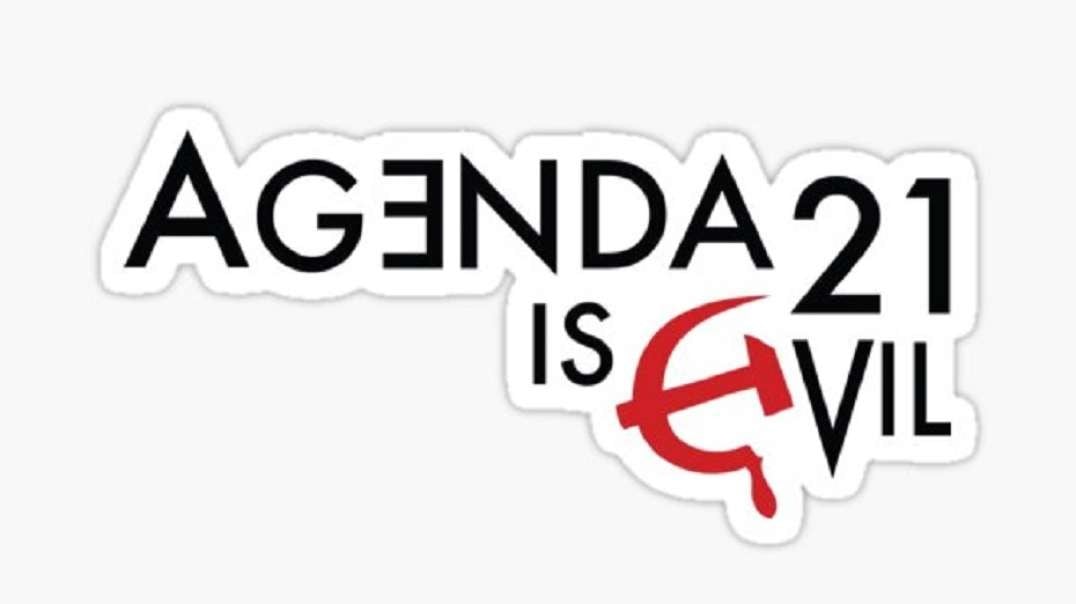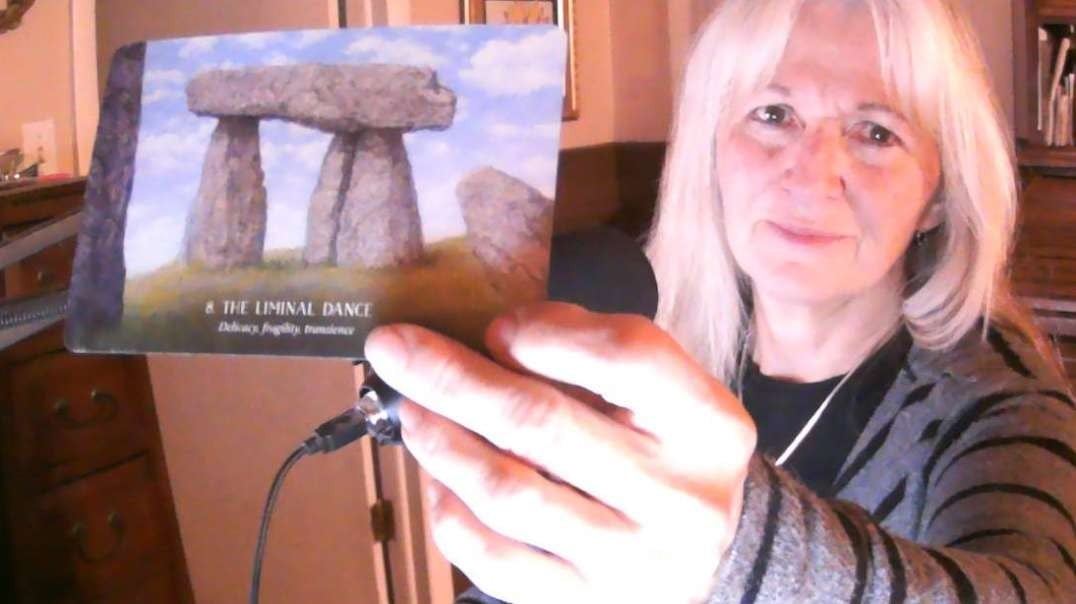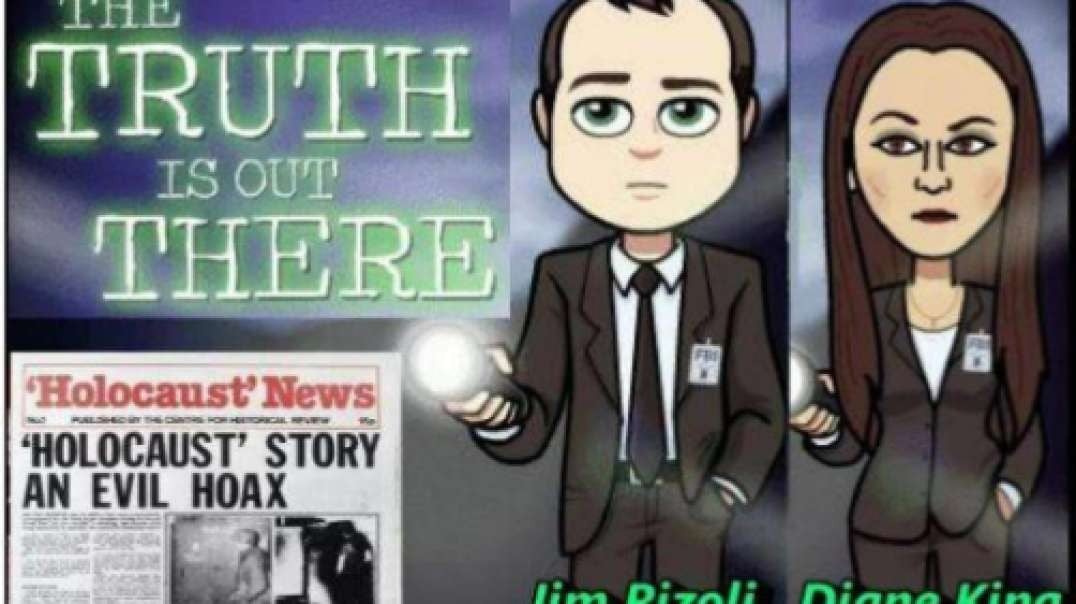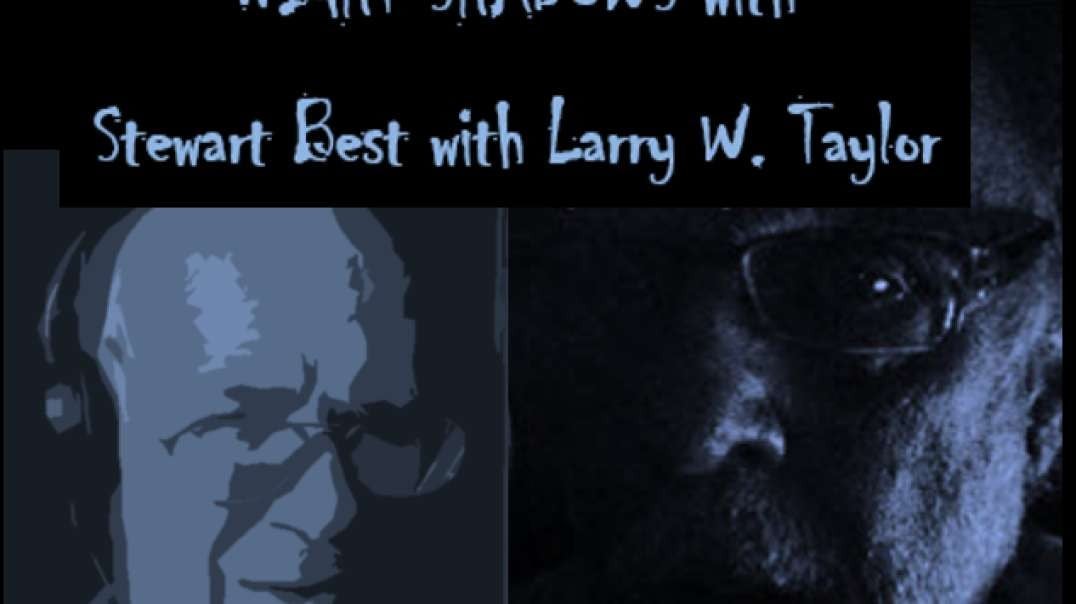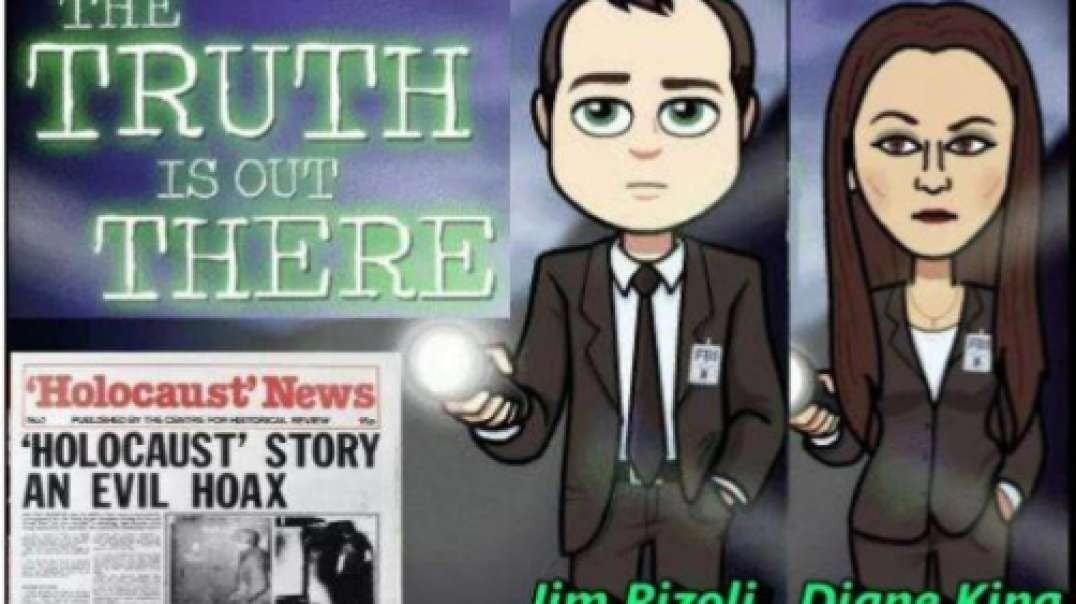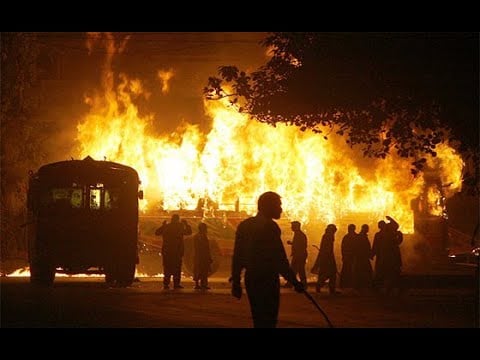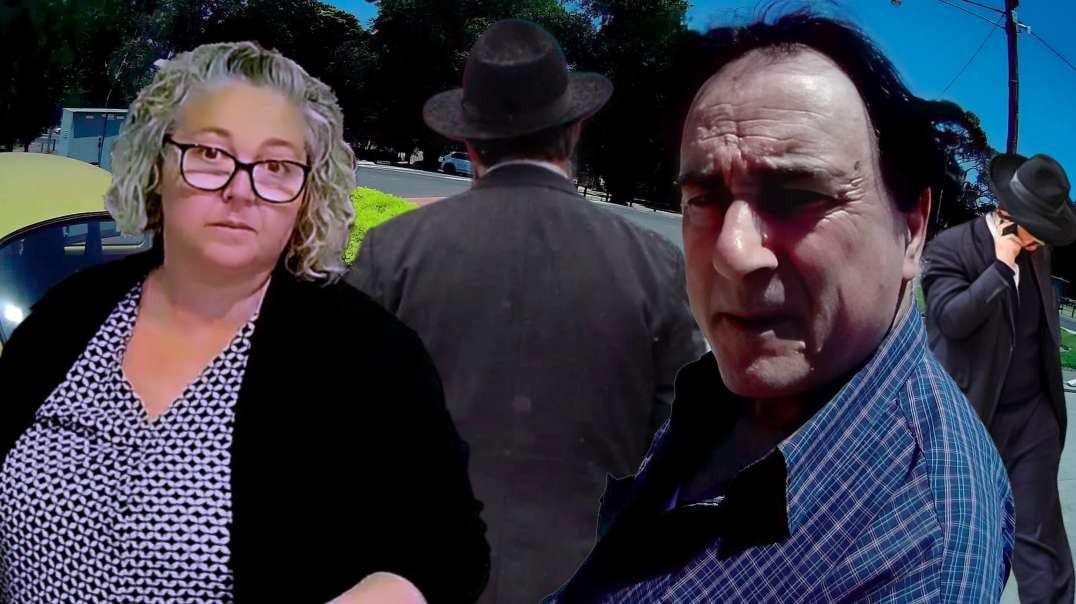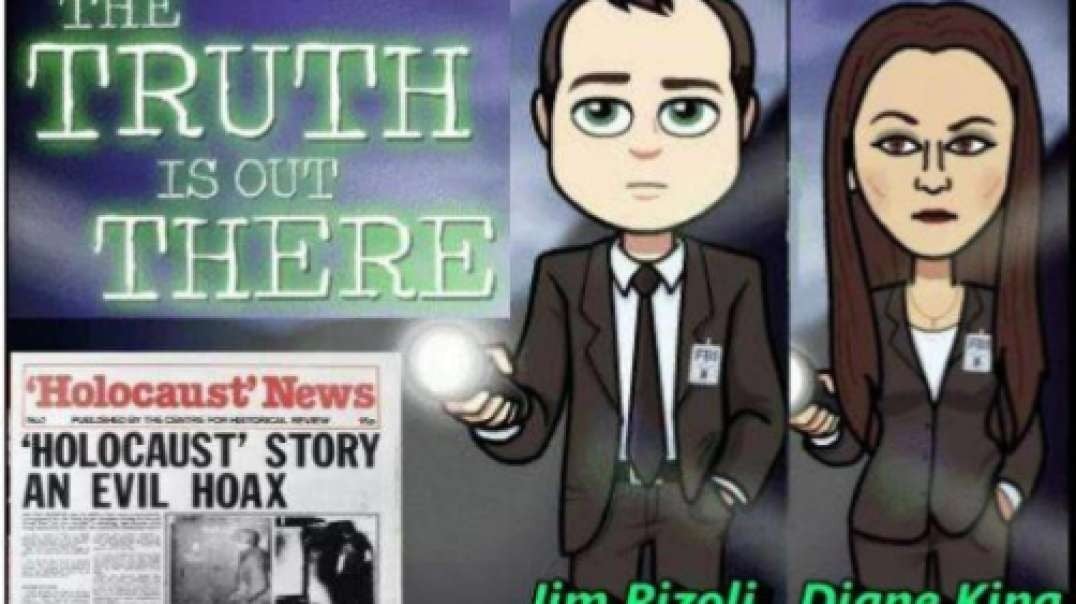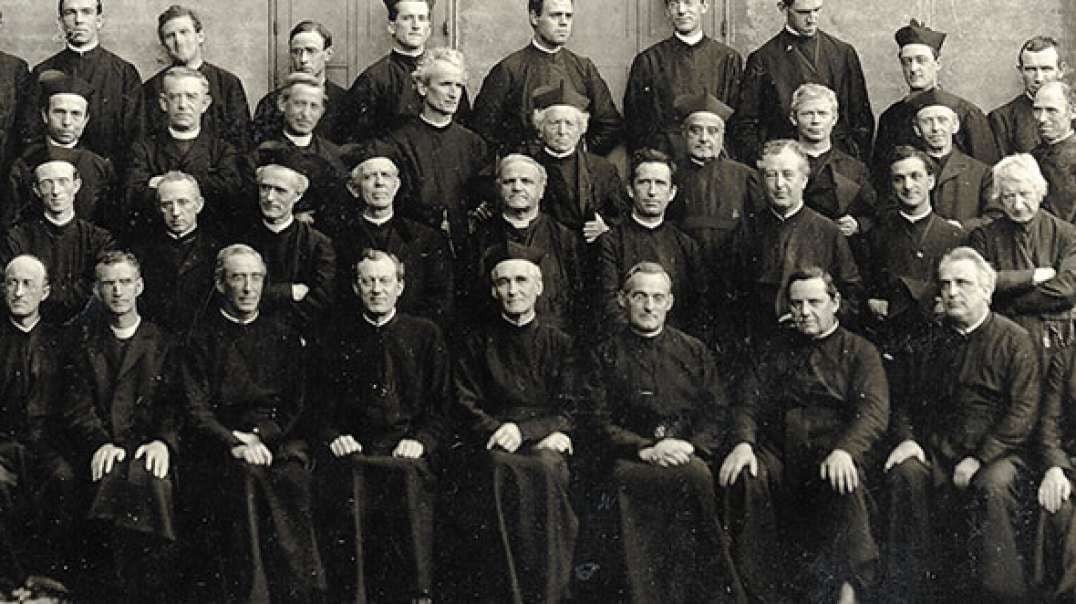Jim and Diane, WALK AND TALK, Oct 19, 2024, EMJ, Hitler, Bogus Accusation - Catholic Persecution
*** EMJ - Was Hitler a Good Catholic, Oct 19, 2024 - https://old.bitchute.com/video/1z8qchrfkwln/
*** Adolf Hitler Had `Some Good Ideas,’ a Fifth of Gen Z Americans Believe, According to Daily Mail Poll
Daily Mail, https://www.dailymail.co.uk/news/article-13950533/Adolf-Hitler-poll-Gen-Z-Nazi-good-ideas.html
*** Had Hitler come against the catholics in the Reich, The pope (with whom he signed the Concordat) would have objected (he did when NS Germany was involved in euthanasia). HE DID NOT come after the catholics in the Reich
Jim's Recommended AH Books
*** THE YOUNG HITLER I KNEW, AUGUST KUBIZEK
PDF - https://www.jrbooksonline.com/PDFs/The%20Young%20Hitler%20I%20Knew%20JR.pdf
*** Jim and Diane Review - GERMANY’S HITLER, Heinz A. Heinz (Sept 2019)
PDF - https://archive.org/details/GermanysHitlerByHeinzA.Heinz
BITCHUTE
Part 1 - https://www.bitchute.com/video/dlKFqS5a2iqB/
Part 2 - https://www.bitchute.com/video/gU1FbVoa5kQ0/
Part 3 - https://www.bitchute.com/video/BXcNff9VASYy/
Part 4 - https://www.bitchute.com/video/9p4XS1OsLDfK/
Part 5 - https://www.bitchute.com/video/Z0zd7TwgJ5iJ/
*** MEIN KAMPF,(PDF) Tom Dalton Translation (Part 1&2)
https://der-fuehrer.org/meinkampf/english/Mein%20Kampf%20(Thomas%20Dalton's%20translation).pdf
*** HITLER DEMOCRAT, Leon Degrelle but available in PDF here
https://vdoc.pub/documents/hitler-democrat-777deqqvnlq0
https://archive.org/details/hdbld
*** ENIGMA OF HITLER, Leon Degrelle:
PDF https://archive.org/details/EnigmaOfAdolfHitlerLeonDegrelle7p
http://www.ihr.org/jhr/v14/v14n3p22_Degrelle.html
"Hitler -- You knew him -- What was he like?" I have been asked that question a thousand times since 1945, and nothing is more difficult to answer ... Hitler's most notable characteristic was ever his simplicity. The most complex of problems resolved itself in his mind into a few basic principles. His actions were geared to ideas and decisions that could be understood by anyone ... His intellectual curiosity was limitless. He was readily familiar with the writings of the most diverse authors, and nothing was too complex for his comprehension ... The universality of Hitler's knowledge may surprise or displease those unaware of it, but it is nonetheless a historical fact: Hitler was one of the most cultivated men of this century.
Complete Article below my critique - DIANE
********
THE CONCORDAT - What did the concordat of 1933 do? By the terms of the concordat the church renounced all political activities and in turn the state guaranteed the right to free worship, to circulate pastoral epistles, to maintain Catholic schools and property.
https://www.google.com/search?q=who+was+the+pope+in+1933&rlz=1C1UEAD_enUS1069US1069&oq=who+was+the+pope+in+1933&aqs=chrome..69i57j0i390i650l3.6725j1j7&sourceid=chrome&ie=UTF-8
Pius XI, original name Ambrogio Damiano Achille Ratti, (born May 31, 1857, Desio, Lombardy, Austrian Empire [now in Italy]—died February 10, 1939, Rome, Italy), Italian pope from 1922 to 1939, one of the most important modern pontiffs.
How Hitler Consolidated Power in Germany and Launched A Social Revolution The First Years of the Third Reich By Léon Degrelle https://www.ihr.org/jhr/v12/v12p299_Degrelle.html
CONCORDAT - The last political factor to go was the clerico-bourgeois "Center" party. Following its vote on March 23 to give Hitler plenary powers, the Center had forfeited all credibility as an opposition party. Its following dwindled away in indifference. After all, if Center leader Monsignor Kaas decided to side with the Führer in the Reichstag, why shouldn't the party's rank and file do likewise? Meanwhile, diplomatic negotiations with the Vatican on a concordat to regulate relations between the German state and the Catholic church were close to a favorable conclusion. In this effort, perhaps more than any other, Hitler manifested patience, cunning, and tact. He needed political peace with the Church, at least until, with the help of the hierarchy, he could count completely on the support of Germany's many Catholics. By voting for Hitler in the Reichstag, Center leader Kaas and his pious clerics had unsuspectingly fallen into a trap. On July 5, 1933, they declared themselves politically neutral and dissolved themselves as a party. As a contemporary observer noted: "All the things being abolished no longer concerned people very much." With regard to the rapid demise of the political parties and the other political forces of both the right and left, Joachim Fest aptly commented: "If anything could have demonstrated the sapped vitality of the Weimar Republic, it was the ease with which the institutions that had sustained it let themselves be overwhelmed." (J. Fest, Hitler, New York: 1974, p. 415.) To abolish the political parties and swallow up their once vast networks of voters took only a scant half year, and with little damage to life or limb. Hitler had succeeded in winning over or at least neutralizing those who had so recently reviled and jeered him. No one was more astonished at the rapidity with which the political parties had succumbed than Hitler himself. "One would never have thought so miserable a collapse possible," he remarked in July 1933, after having thrown the last shovelful of dirt on the graves of the Weimar Republic's once mighty parties. (J. Fest, Hitler, p. 415.)
VIDEO: CODOH PRIEST ARTICLE, July 4, 2023 (below)
https://www.bitchute.com/video/N5PeW3jHnErC/
https://www.goyimtv.com/v/2491579684/Jim-and-Diane-Walk-and-Talk--4TH--CODOH-Priest-Article--July-4--2023
https://odysee.com/@RizoliTV:d/Jim-and-Diane-Walk-and-Talk,-4TH,-CODOH-Priest-Article,-July-4,-2023:9
https://ugetube.com/watch/jim-....and-diane-walk-and-t
*** Clergy Imprisoned in Dachau: A Critical Examination, John Wear: [dkk: They definitely use the term ‘critical’ loosely, not questioning the ‘eyewitness’ testimony sources as well as ANYTHING that would come from a war crimes trial against the Germans. John Wear ought to know better]
https://www.google.com/search?q=clergy+Imprisoned+in+Dachau%3A+A+Critical+Examination%2C+John+Wear&rlz=1C1UEAD_enUS1069US1069&oq=clergy+Imprisoned+in+Dachau%3A+A+Critical+Examination%2C+John+Wear&gs_lcrp=EgZjaHJvbWUyBggAEEUYOTIGCAEQRRg70gEIMTgyMmowajeoAgCwAgA&sourceid=chrome&ie=UTF-8
The Priest Barracks of Dachau Concentration (in German Pfarrerblock, or Priesterblock) incarcerated clergy who had opposed the Nazi regime of Adolf Hitler. From December 1940, Berlin ordered the transfer of clerical prisoners held at other camps, and Dachau became the centre for imprisonment of clergymen.
*** Dachau was a reeducation camp for the anti-NS, pro-Communist activist dissidents. What did these priests do? It wasn't because they were priests. Or there would have been a Reich Roundup of all the priests and then there would have been an outrage by the citizenry. Not to mention, a call from the Vatican concerning the terms of the CONCORDAT!!!
*** This paragraph, "Dachau, was used as a center for medical experimentation on humans involving malaria (and a number of things). I have an issue with the following: "... this has been corroborated by hundreds of documents and by witnesses in the doctors' trial at Nuremberg 1946 to 1947."
Since when have we had any credence given to captured documents and results from ANY Nuremberg trial of ANY KIND!
*** In Dachau, it was understood that experimentation use was offered on a voluntary basis for consideration like early release.
*** Much of the quotations concerning prisoner conditions were taken from the book, The Priest's Barracks: 1938 to 1945 by Guillaume Zeller,
which sounds like a Jewish person to me. Nearly all of these books mentioned are suspicious because of their slanted (likely jewish) bent.
*** Another individual, Nauhausler, wrote a book indicating the following: " ... a table that 868 out of 1780 Polish priests and 166 out of 949 Polish clergyman died in DACHAU. However, he did not reference where he obtained the figures in his table. Moreover, as a special prisoner separated from the general camp, he wrote that he could not learn all that happened. His statistics did not originate from his personal experience in Dachau. HE WASN'T THERE
So anything he says is suspect.
*** Then a Jewish historian, Harold Marcuse writes about the survival rate of priests in Dachau.
[dkk: Since when are Jewish sources used as any credible evidence of anything particularly death rates or statistics involving NS Germany.]
*** Another disputable paragraph dealt with: Dachau, 1933 to 1945: The Official History, Paul Berben using the table presented above indicating that more had died because of poor clothes in the winter. Zeller writes that more than 300 of these mostly elderly disabled Polish clergymen were sent to the carbon monoxide gas chamber at Hartheim Castle (Linz) in Austria. (UM, WHAT!!!) Let's take a look at the circumstances surrounding Hartheim Castle near Linz.
*** The expansion of the city, (Linz) which continued in leaps and bounds from 1938 (Eblelsberg and St. Magdalena become separate parishes) occurred in connection with Adolf Hitler’s intention of making Linz an industrial, administrative and cultural centre. This results in the recruitment of thousands of forced labourers and the construction of three concentration camps.
*** The Red Army occupied only parts of Austria, including the capital, while the Anglo-American troops entered from Germany and Italy. Thereafter, France, Great Britain, the United States, and the Soviet Union divided Austria into four occupation zones, much like they did in Germany. The Soviets were heading for Linz.
(dkk): Totally bogus. Why in the world would John Wear even give these posers any kind of credence like torture in this castle that likely was in Soviet control - I mean, THEY specialize in this and blaming the Germans!
THE following IS THE MOST EGREGIOUS ASSAULT AGAINST THE TRUTH: *** He continues with Berben also wrote that 304 members of the Polish clergy were exterminated in various ways including liquidated inside the camp in the showers or in the bunker. Berben did not explain how Polish priests could have been exterminated in the showers at Dachau. Historians and former Dachau inmates generally agree that there were no functioning gas chambers inside Dachau. Berben, in his own book, even stated that the Dachau gas chamber was never operated. dkk: More bogus nonsense
*** The Allies tended to mistreat the clergy after the war but not much is mentioned about that.
*** Martin Niemoller a Lutheran clergy was cited discussing the poor treatment of the German population. But also the good treatment he received while in Dachau but he is supposed to be some kind of martyr????!!! I thought he was executed - according to his book, but maybe that was wishful thinking posthumously. Or the Allies killed him.
Clergy Imprisoned in Dachau: A Critical Examination: [dkk: They definitely use the term ‘critical’ loosely, not questioning the ‘eyewitness’ testimony sources as well as ANYTHING that would come from a war crimes trial against the Germans.] https://codoh.com/news/3496/
Dachau was used partially as a detainment facility for Christian clergy in Europe. There were more than 1,000 clergymen in Dachau in 1940, which was about 4% of the inmates in Dachau that year. After 1940 all priests imprisoned by Germany were relocated to Dachau, with a total of 2,762 clergymen imprisoned in Dachau by the end of the war. Catholics made up 2,579 of this total, while the rest were mostly Protestant ministers.[i] The largest national contingent was from Poland (1,780, or 64%), with the Germans (447, or 16%) and other nationalities following far behind. The clergymen were housed in barrack numbers 26, 28 and 30 in the northwest corner of the camp. They were initially allowed to convert one room of barrack 26 into a chapel, but after 1941 the Polish priests in barrack 28 were barred from using this chapel.[ii] his article examines some of the mistreatment and crimes committed against the clergymen in Dachau. It also examines the hardships suffered by Dachau clergymen after the war, as well as the positive benefits from their internment in Dachau.
Medical Experimentation: Dachau was used as a center for medical experimentation on humans involving malaria, high altitudes, freezing, phlegmon, and other experiments. This has been corroborated by hundreds of documents and by witnesses in the Doctors’ Trial at Nuremberg, which opened on December 9, 1946, and ended on July 19, 1947.[iii] The malaria experimentation at Dachau was performed by Dr. Klaus Karl Schilling, who was an internationally famous parasitologist. Dr. Schilling was ordered by Heinrich Himmler in 1936 to conduct medical research at Dachau for the purpose of specifically immunizing individuals against malaria. The medical supervisor at Dachau would select the people to be inoculated and then send this list of people to Berlin to be approved by a higher authority. Those who were chosen were then turned over to Dr. Schilling to conduct the medical experimentation.[iv] A total of 176 Polish priests, four Czechs and five German clergymen were subject to malaria experimentation at Dachau. Two priests died as a result of these malaria experiments: Father Josef Horky from Czechoslovakia, and Father Francis Dachtera from Poland. It is also possible that other clergymen died from indirect pathologies such as tuberculosis or renal failure induced by these malaria experiments.[v]
Phlegmons were induced in inmates at Dachau by intravenous and intramuscular injection of pus. Various natural, allopathic and biochemical remedies were then used to attempt to cure the resulting infections. The phlegmon experiments were conducted by National Socialist Germany to find an antibiotic similar to penicillin for the infection.[vi] A total of 40 clergymen in Dachau were subject to phlegmon experiments. Eleven out of this group died, and many of the survivors suffered adverse health effects from these experiments.[vii] Another Catholic priest who had survived malaria experimentation, Father Leo Michalowski, was selected to undergo tests of his resistance to immersion in ice water. Although Michalowski survived this experiment, it left him with a weak heart for the rest of his life.[viii]
Typhus: The first typhus epidemic at Dachau began in December 1942. Quarantine measures were taken to prevent its spread. The end of this typhus epidemic was declared on March 14, 1943, with the disease killing between 100 and 250 inmates in the camp.[ix] The second typhus epidemic struck Dachau in December 1944 and was much more widespread. This outbreak of endemic typhus caused the 15 blocks in the eastern part of the camp to be isolated from the rest of the camp. Many of the priests in Dachau volunteered to alleviate the sufferings of these sick Dachau inmates. These volunteer priests were all contaminated by typhus, and most of them died as a result.[x]
Typhus was the primary reason for the huge piles of dead bodies at Dachau when U.S. troops entered the camp. Dr. Charles P. Larson, an American forensic pathologist, was at Dachau and conducted hundreds of autopsies at Dachau and some of its sub-camps. Dr. Larson stated in regard to these autopsies: “Many of them died from typhus. Dachau’s crematoriums couldn’t keep up with the burning of the bodies. They did not have enough oil to keep the incinerators going. I found that a number of the victims had also died from tuberculosis. All of them were malnourished. The medical facilities were most inadequate. There was no sanitation…”[xi]
Dr. John E. Gordon, M.D., Ph.D., a professor of preventive medicine and epidemiology at the Harvard University School of Public Health, was with U.S. forces at the end of World War II. Dr. Gordon determined that disease, and especially typhus, was the number one cause of death in the German camps. Dr. Gordon explained the causes for the outbreaks of disease and typhus: Germany in the spring months of April and May [1945] was an astounding sight, a mixture of humanity traveling this way and that, homeless, often hungry and carrying typhus with them…
Germany was in chaos. The destruction of whole cities and the path left by advancing armies produced a disruption of living conditions contributing to the spread of disease. Sanitation was low grade, public utilities were seriously disrupted, food supply and food distribution was poor, housing was inadequate and order and discipline were everywhere lacking. Still more important, a shifting of population was occurring such as few times have experienced.[xii]
Famine: The food rations received by inmates in German concentration camps decreased in May 1942 due to shortages caused by the devastated-German-war effort. These shortages became a famine, which reached its nadir in midsummer 1942. The weight of the clergymen in Dachau dropped substantially due to the inadequate food supply.[xiii] The death rate in Dachau rose substantially, and the clergy did not escape this general misery.[xiv]
Conditions began to improve in Dachau when Martin Weiss became camp commandant in August 1942. Paul Berben wrote: From November [1942] food parcels could be sent to clergy and the food situation improved noticeably. Germans and Poles particularly received them in considerable quantities from their families, their parishioners and members of religious communities. In Block 26 100 [parcels] sometimes arrived on the same day. This all bore witness to the continuing feeling of Christian fellowship which survived all persecution…
This period of relative plenty lasted till the end of 1944 when the disruption of communications stopped the dispatch of parcels. Nevertheless, the German clergy continued to receive food through the Dean of Dachau, Herr Pfanzelt, to whom the correspondents sent food tickets…[xv] As the Allies closed in on the center of Germany toward the end of the war, large numbers of prisoners were evacuated from camps near the front and moved to the interior. Dachau, being centrally located, was a key camp for these transfers. So while food became more difficult to obtain, the demand for food increased with the transfer of prisoners to Dachau from other camps. This resulted in major food shortages at Dachau and a major increase in deaths in the camp near the end of the war.[xvi]
Polish Priest Deaths: The book The Priest Barracks: Dachau, 1938-1945 by Guillaume Zeller states that National Socialist Germany was intent on killing the Polish elite.[xvii] Zeller claims that 868 out of 1,780 Polish priests died during their internment in Dachau. This death rate of over 48% of the Polish priests in Dachau is supported by a book written by Johann Neuhäusler, who was interned in Dachau from July 1941 to April 1945.[xviii] Neuhäusler’s book used a table indicating that 868 out of 1,780 Polish priests and 166 out of 940 non-Polish clergymen died in Dachau. However, Neuhäusler did not reference where he obtained the figures in his table. Moreover, as a “special prisoner” separated from the general camp, Neuhäusler wrote that he could not learn all that happened in Dachau. Neuhäusler’s statistics did not originate from his personal experience in Dachau.[xix]
Jewish historian Harold Marcuse writes about the survival rate of priests in Dachau: The 2,579 Catholic clergymen imprisoned in the Dachau concentration camp had been a special group among the camp inmates. We recall that in 1940 all of the Christian clergymen being held in “protective custody” in the Reich—about 1,000 at that time—were consolidated in Dachau…About 450 of the final number were German or Austrian (the Poles with 1,780 were the largest national group), and they had a relatively high survival rate.[xx]
In his book Dachau, 1933-1945: The Official History, Paul Berben used Neuhäusler’s table indicating that 868 out of 1,780 Polish priests in Dachau died.[xxi] Berben wrote that some 500 Polish clergy, most of them elderly, arrived in Dachau by train in deplorable condition on October 29, 1941. Berben said these clergymen were not issued adequate winter clothes, and that only 82 survived their internment in Dachau.[xxii] Zeller writes that more than 300 of these mostly elderly disabled Polish clergymen were sent to the carbon-monoxide gas chamber at Hartheim Castle in Austria.[xxiii] Berben also wrote that 304 members of the Polish clergy were exterminated in various ways, including “liquidated inside the camp, in the showers or in the Bunker.”[xxiv] Berben did not explain how Polish priests could have been exterminated in the showers at Dachau. Historians and former Dachau inmates generally agree that there were no functioning gas chambers inside Dachau.[xxv] Berben in his own book even stated that “the Dachau gas chamber was never operated.”[xxvi]
Dachau Clergy Mistreated After Liberation: The Americans who liberated Dachau were intent on exploiting Dachau for propaganda purposes. Photographers repeatedly visited Dachau to take pictures and film newsreel footage of the dead. Some clergymen petitioned American authorities to improve their lot. For example, Father Michel Riquet protested in a letter to Gen. Dwight Eisenhower, commander-in-chief of the Allied forces: You will understand our impatience and even our astonishment at the fact that, more than 10 days after greeting our liberators, the 34,000 detainees of Dachau are still prisoners of the same barbed-wire fences, guarded by sentinels whose orders are still to fire on anyone who attempts to escape—which for every prisoner is a natural right, especially when he is told that he is free and victorious. In the barracks that are visited every day by the international press, some men continue to stagnate, stacked in these triple-decker beds that dysentery turns into a filthy cesspool, while the lanes between the blocks continue to be lined with cadavers—135 per day—just like in the darker times of the tyranny that you conquered.[xxvii]
The German clergymen who left Dachau also discovered that Germans were facing severe deprivations and starvation after the war. German Protestant Church president and former Dachau prisoner Martin Niemöller said to an American audience when he toured the United States from December 1946 to April 1947: The offices of our [American] military government are very nicely and cozily heated and our military government people live a good life as far as nourishment and everything else, even housing, is concerned. But they don’t know how people really think and react who are hungry, who are on the way to starving. Niemöller claimed that Germans were receiving no better than “the lowest ration ever heard of in a Nazi concentration camp.”[xxviii] Although Niemöller raised more money than expected from his American tour, he was disappointed in its outcome because he was not able to improve U.S. occupation policies in Germany. After months in America, Niemöller’s return to war-ravaged Germany came as a shock. Niemöller wrote to Pastor Ewart Turner:
The winter is over, but you feel it everywhere—in the cold which is still harboring in the rooms, especially in this old castle with its thick stone walls. The water pipes are broken. No running water in kitchen or toilet. Sitting at my desk I shiver from cold even now, and the only place where I feel some relief is once again in the bed. The food situation is more than difficult, and I scarcely dare to take a slice of bread, thinking that Hertha, Tini, and Hermann [his children] are far more in need of having it than I, and I can’t help feeling guilty for being so well fed [in the United States]. The whole aspect of life is grim and dark; you see the traces of progressive starvation in every face you come to see.[xxix] The physical and emotional toll of hunger, cold and disillusionment made life in Germany intolerable for Niemöller. Niemöller’s wife Else bemoaned when they got back to Germany from America, “It was so much easier there than here.” Niemöller told Pastor Turner that if things didn’t improve, “I should prefer to be back in my cell number 31 at Dachau.” Niemöller blamed “the followers of the Morgenthau Plan” who had moved their “headquarters from Washington to the American Zone.”[xxx] In another letter to Turner in the fall of 1947, Niemöller wrote: The [coming] winter will be a very severe test for all of us. The rations in fat and meat have been cut again to 25 grams of butter and 100 grams of meat a week! And no potatoes. The normal consumer probably will die this winter, and that Jew [in the occupation forces] will have been right who answered my question, what would become of the too many people in the Western Zones, by saying: “Don’t worry, we shall look after that and the problem will be solved in quite a natural way!” Niemöller understood the Jewish official’s phrase “a natural way” to mean death by starvation.[xxxi]
Positive Aspects of Dachau Internment: Many clergymen in Dachau came to view their imprisonment in Dachau as a positive experience. Father Leo de Coninck summarized his stay in Dachau: “Three years of experiences that I would not have missed for anything in the world.” While Father de Coninck’s statement may be surprising, his statement recurs in the testimonies of many clergymen imprisoned in Dachau.[xxxii] Martin Niemöller, for example, had some fond memories of Dachau. On his speaking tour in America, Niemöller recalled sharing quarters with three Catholic priests in Dachau and praying together “according to the Roman customs every morning, every noontime, and every night.” Niemöller said: “We became brethren in Christ not only by praying together but by common listening to the Word of God.” Without fail, Niemöller told the story of his international and multi-denominational congregation on Christmas Eve 1944 in Dachau.[xxxiii] Catholic Bishop Johannes Neuhäusler also preferred not to think about his bad experiences in Dachau. Neuhäusler said: “I prefer to speak about the nice memories associated with the name Dachau,” such as the ecumenical Bible readings in the camp, and the Christmas tree the SS set up for prisoners in 1941.[xxxiv] Father Maurus Münch said: “Dachau was, in the designs of Providence, the cradle of ecumenism lived out completely. Never in the history of the people of God had there been so many secular and religious priests of all Christian confessions, [who were] united in a community of life and suffering, as during the great witness of Dachau.” While Catholic priests made up the vast majority of clergymen in Dachau, they established friendly and fraternal relations with Protestant pastors and clergymen of other faiths.[xxxv]
Dachau became a laboratory for ecumenical dialogue. Father Münch wrote: In Dachau, we were united fraternally in the breath of the Holy Spirit, strengthened in Christ to serve Him behind the watchtowers, the electrified fences and the barbed wire. We sought unity in our discussions and our dialogues….In authentic fraternity and common prayer, we laid the foundations for new relations between the different churches….The priests in Dachau and the Christian laymen took home with them, to their churches and their families, the lived experience of unity.[xxxvi]
Conclusion:
*** Historian Nikolaus Wachsmann writes regarding prisoner deaths in German concentration camps, “[T]he precise number of victims will never be known.”[xxxvii] While precise numbers can never be determined, some historians have made reasonable attempts to document the number of deaths in Dachau.
*** Harold Marcuse writes that the most reliable figures today set the total number of inmates in Dachau at 206,206, of whom at least 31,591 are documented to have died or been killed prior to liberation.[xxxviii] Paul Berben wrote that the total number of people who passed through Dachau during its existence is well in excess of 200,000.[xxxix] Berben concluded that while no one will ever know the exact number of deaths at Dachau, the number of deaths is probably several thousand more than the quoted number of 31,951.[xl]
*** Berben documented that approximately 66% of all deaths at Dachau occurred during the final seven months of the war. The increase in deaths at Dachau was caused primarily by a devastating typhus epidemic which, in spite of the efforts made by the medical staff, continued to spread throughout Dachau. The number of deaths at Dachau also includes 2,226 people who died in May 1945 after the Allies had liberated the camp, as well as the deaths of 223 prisoners in March 1944 from Allied bombings of Kommandos.[xli]
Based on these statistics, less than 17% of the inmates died in Dachau before, during and after World War II. The vast majority of these deaths, including the deaths of the European clergymen in Dachau, were from natural causes.
*******************
ADOLF HITLER AND THE THIRD REICH
1) GERMANY'S HITLER, Heinz A. Heinz, $12.68, free shipping, Prime
https://www.amazon.com/Germanys-Hitler-Heinz/dp/1366820304
2) THE YOUNG HITLER I KNEW, August Kubicek
https://www.google.com/search?q=kubizek+the+young+hitler+i+knew&rlz=1C1UEAD_enUS1069US1069&oq=kubizek+the+young+hitler+i+knew&gs_lcrp=EgZjaHJvbWUqCQgAECMYJxiKBTIJCAAQIxgnGIoFMgcIARAuGIAEMgoIAhAAGIYDGIoF0gEIMTkxMGowajeoAgCwAgA&sourceid=chrome&ie=UTF-8
3) MEIN KAMPF,(PDF) Tom Dalton Translation (Part 1&2)
https://der-fuehrer.org/meinkampf/english/Mein%20Kampf%20(Thomas%20Dalton's%20translation).pdf
or
MEINKAMPF, STALAG 17 Edition
https://www.moneytreepublishing.com/shop/mein-kampf
($50) Softcover • 6” X 9” • 612 pages
The only complete, unabridged, and officially authorized English translation ever issued by the National Socialist German Workers’ Party (NSDAP), translated by a now-unknown English-speaking party member, printed by the Franz Eher Verlag in Berlin for the Central Press of the NSDAP in limited numbers from 1937-44.
4) HITLER DEMOCRAT, Leon DeGrelle (PDF here)
https://vdoc.pub/documents/hitler-democrat-777deqqvnlq0
https://archive.org/details/hdbld
